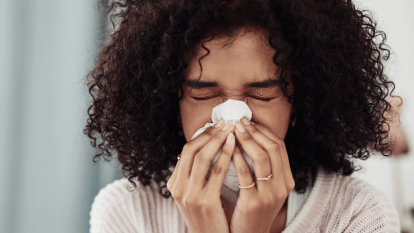What Is Flurona? Here’s Everything You Need To Know — And How To Stay Safe

The emergence of Omicron has made this winter difficult, to say the least. It took just a few weeks for the variant to skyrocket in the US. And as we wait and hope for Omicron to subside, another problem brews: Flurona.
What is “flurona,” exactly? “‘Flurona’ refers to the coinfection of the flu and COVID-19 respiratory viruses at the same time,” says Dr. Saskia Popescu, infectious disease epidemiologist and Clorox spokesperson. This means that, thankfully, flurona isn’t a new mutation of the coronavirus. However, it’s still a cause for concern. A double infection could make you very ill, and could be deadly for some.
We get it — no one wants to hear new terminology at this stage of the pandemic. Ignoring it, however, won’t make it go away. Here’s what you need to know about “flurona,” and how you can protect yourself and others from a double infection.
How common is “flurona”?
While “flurona” is making headlines now, it has existed since the beginning of the pandemic. The Atlantic reports that a man in Queens, New York tested positive for both COVID-19 and the flu back in February 2020. In addition, a teenager from Houston, Texas contracted both viruses this month, as did several children in South Florida.
While news outlets will likely continue to report individual cases, experts don’t know just how many people are contracting “flurona.” However, scientists agree that the concern is justified. A “twindemic” could seriously overwhelm hospitals, according to The Washington Post.
What are the symptoms of “flurona”?
The CDC notes that COVID-19 and the flu often have similar symptoms. These include:
- Fever and/or chills
- Cough
- Shortness of breath or difficulty breathing
- Fatigue
- Sore throat
- Runny or stuffy nose
- Muscle pain
- Body aches
- Headache
- Vomiting
- Diarrhea
Patients may also experience a change in or loss of taste or smell, though this symptom is more common in COVID-19.
Since the symptoms are so similar, it’s important to get tested for both viruses. Fortunately, the CDC notes that vaccinations against both diseases significantly reduce the severity of symptoms.
How to Prevent “Flurona”
In order to prevent yourself from contracting both diseases at the same time (and to slow the spread), it’s important to follow health safety guidelines. “Both flu and COVID-19 viruses spread similarly, so we can prevent transmission through similar strategies,” says Dr. Popescu. “[That includes] staying home when we’re sick, wearing a mask when out in public, social distancing, avoiding crowded indoor spaces, washing hands, and getting vaccinated.”
Popescu believes that we should still be disinfecting high-touch surfaces, too. “Because flu germs can live on surfaces for up to 48 hours, using Clorox Disinfecting Wipes (Buy from Amazon, $2.58) to disinfect high-touch surfaces remains a critical part of preventing the spread.”
In addition, experts warn that cloth masks aren’t enough to protect us from Omicron. So, make sure you’re wearing a certified N95, KN95, or KF94 mask. Not sure which type to buy? Check out our guide on purchasing the right ones. Make sure you are disinfecting your masks properly, too! With a little extra care and thought, you can protect yourself and your loved ones from a double infection.













